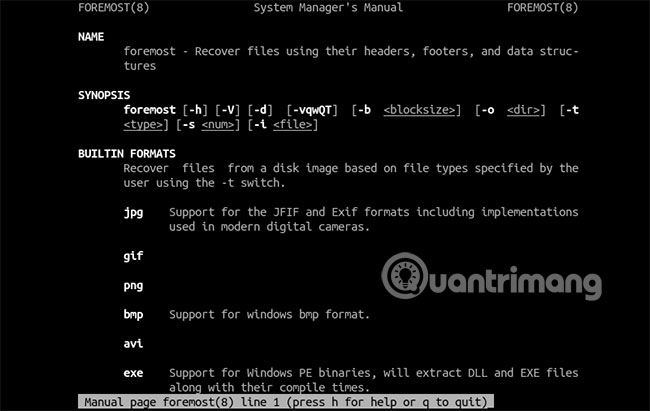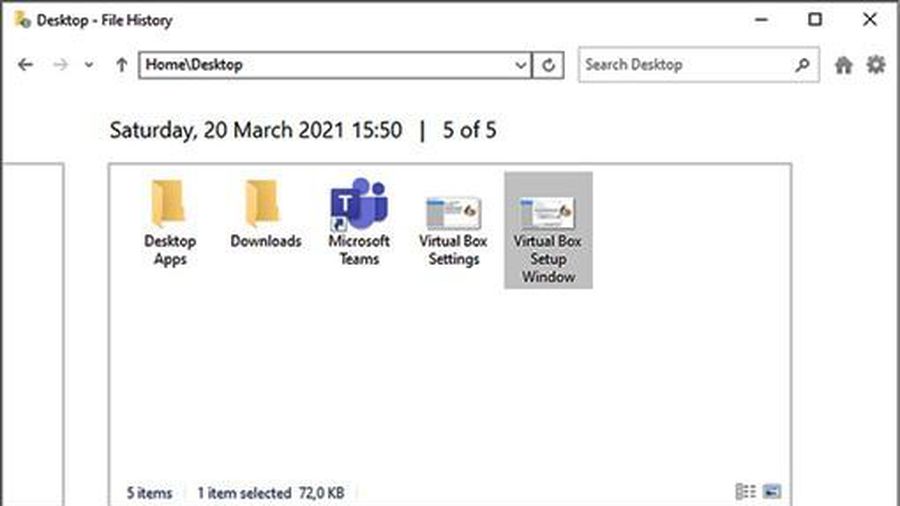How to use Foremost to recover deleted files in Linux
The rm command is one of the most dangerous commands for Linux users. If you delete the wrong file or directory, you can make your entire operating system unusable. Recovering lost files is not easy, but it is also not possible. Foremost is designed to diagnose your hard drive in order to recover any files you have deleted. This article provides a tutorial on how to use the Foremost tool.
What is foremost?
Developed by US federal agencies, Foremost (link: http://foremost.sourceforge.net/ ) is open source software. Instead of trying to retrieve files from the hard drive's file system, Foremost tries to directly recreate those files.

Most operating systems do not delete files completely from the file system. They only delete metadata and leave the data written below. Foremost will then copy and analyze the drive for this information.
Foremost will store information temporarily using memory in your PC. From there, it will look for certain file segments (segments) until it matches other segments, stitching them together (like a jigsaw puzzle).
Foremost supports certain file types. Image files like JPG and GIF, Windows binary files like EXE, document files like DOC and PDF, as well as compressed file formats like ZIP or RAR are all supported.
Install Foremost in Linux
Foremost is available as a package to install in most default Linux repositories. You can install it from the terminal using the package manager used by the Linux distribution.

Debian and Ubuntu-based distributions can install Foremost by opening a terminal and typing the following:
sudo apt install foremost If you are running Arch Linux, you can install Foremost by entering:
pacman -S foremost Fedora users can install Foremost from the terminal by typing:
dnf install foremost How to use Foremost
If you have deleted a file and want to retrieve it, you can use Foremost to search for all files of the same type that were previously deleted.
First, you will need to know your drive partition name in Linux, for example '/ dev / sda1'. If you do not know your partition, enter the following into the terminal:
df -h You will see a list of hard drive partitions listed. Locate the drive you want Foremost to search, listed in 'Filesystem'.

Once you know your hard drive partition, you can use Foremost to search your drive. For example, if you are looking for a deleted PNG file, open a terminal window and type the following:
foremost -v -t png -i /dev/sda1 -o ~/recovery/ Replace '/ dev / sda1' with your hard drive partition. The -t flag allows you to select the file type to search for. The -i flag selects the drive you want to search, while the -o flag lists the directory where any restored files are stored.

You can use a similar procedure for any type of file you want to use. Replace png with your file type. You can search the entire drive or through specific directories.
When Forecast completes the search, all the files it locates will be saved in the output directory you listed under the -o flag . If you have difficulty, you can search through the Forecast's user guide by typing in the terminal:
man foremost Retrieve deleted data in Linux
There is no guarantee that Foremost can recover any data you have lost or deleted. However, this is still one of the best free tools for retrieving data.
Unless you're willing to spend money on a better tool, Foremost is one of the best options available for accessing data in Linux. If Foremost doesn't work in your case, there are other Linux recovery tools available that you can try instead.
Hope you are succesful.
You should read it
- Trick to recover Android data is lost
- How to recover deleted data or Secure format
- Recover deleted files from the cloud service
- Recover deleted data with Recuva
- How to recover deleted files on Android phones
- How to recover deleted photos on Android device?
- Steps to recover deleted files on USB and External Hard Drive
- How to recover, retrieve deleted files in trash
May be interested
- How to recover, retrieve deleted files in trash
 how to recover, retrieve deleted files in trash. in the course of using the computer, you have probably encountered a case of mistakenly deleting data. if you are in that case, don't worry, because when we delete a file in windows, the file
how to recover, retrieve deleted files in trash. in the course of using the computer, you have probably encountered a case of mistakenly deleting data. if you are in that case, don't worry, because when we delete a file in windows, the file - Recover deleted files in Exchange Server 2003 (Part I)
 today we will introduce the series on recovering deleted files on exchange server 2003. this series is divided into two parts, the first part introduces how to recover data at the mailbox storage level. part two will discuss dry matter
today we will introduce the series on recovering deleted files on exchange server 2003. this series is divided into two parts, the first part introduces how to recover data at the mailbox storage level. part two will discuss dry matter - How to recover deleted files on iCloud Drive
 how to recover deleted files on icloud drive. icloud drive is apple's cloud service that helps us transfer data in apple devices like iphone, ipod, ipad, macboook ... easily. in addition, we can also use icloud drive to create a backup of data
how to recover deleted files on icloud drive. icloud drive is apple's cloud service that helps us transfer data in apple devices like iphone, ipod, ipad, macboook ... easily. in addition, we can also use icloud drive to create a backup of data - How to recover deleted files in Windows 10
 you can delete unused files on your computer to increase free space, or for privacy reasons. however, during the cleaning process, you accidentally delete some important files by mistake. so is it possible to recover? here are ways that can help you fix the mistake, even of permanently deleted files.
you can delete unused files on your computer to increase free space, or for privacy reasons. however, during the cleaning process, you accidentally delete some important files by mistake. so is it possible to recover? here are ways that can help you fix the mistake, even of permanently deleted files. - How to recover deleted files on Microsoft Teams
 in case of accidental deletion of an important file on microsoft teams, how do you get it back? please follow the article below to know how to recover deleted files on microsoft teams
in case of accidental deletion of an important file on microsoft teams, how do you get it back? please follow the article below to know how to recover deleted files on microsoft teams - Instructions for finding and recovering deleted data
 what would you do if after deleting a file but realized it was an important file? or is there a file that is suddenly infected by virus and then deleted by antivirus software? undelete 360 is an effective solution that can be used in this case.
what would you do if after deleting a file but realized it was an important file? or is there a file that is suddenly infected by virus and then deleted by antivirus software? undelete 360 is an effective solution that can be used in this case. - How to recover deleted photos on Android device?
 if you accidentally delete your favorite pictures on your android device, don't worry too much, or blame yourself for doing anything. there are still some solutions for you to choose to restore these deleted images.
if you accidentally delete your favorite pictures on your android device, don't worry too much, or blame yourself for doing anything. there are still some solutions for you to choose to restore these deleted images. - How to recover files and data deleted by Avast by mistake
 how to recover files and data deleted by avast by mistake. avast is not perfect, sometimes the software will delete your data file by mistake. so how to recover, recover files when avast deleted by mistake?
how to recover files and data deleted by avast by mistake. avast is not perfect, sometimes the software will delete your data file by mistake. so how to recover, recover files when avast deleted by mistake? - Recover accidentally deleted data in USB
 when you mistakenly delete data on a usb that is quite important to you, you do not know how to recover those deleted data? softorbits flash drive recovery is a software that helps recover deleted data on usb quickly.
when you mistakenly delete data on a usb that is quite important to you, you do not know how to recover those deleted data? softorbits flash drive recovery is a software that helps recover deleted data on usb quickly. - How to recover deleted files permanently in the trash
 sometimes you want to temporarily delete a file or a folder in the trash (recycle bin) but accidentally miss shift + delete or empty recycle bin and so all data is gone completely. however, we can still save deleted data by tips in the article below.
sometimes you want to temporarily delete a file or a folder in the trash (recycle bin) but accidentally miss shift + delete or empty recycle bin and so all data is gone completely. however, we can still save deleted data by tips in the article below.










 8 ways Ubuntu changes and improves Linux
8 ways Ubuntu changes and improves Linux How to turn any Linux PC into HTPC without Kodibuntu
How to turn any Linux PC into HTPC without Kodibuntu How to get an explanation of the command in a terminal with Kmdr
How to get an explanation of the command in a terminal with Kmdr How to use the 'echo' command in Linux
How to use the 'echo' command in Linux How to find out if the package is installed in Linux
How to find out if the package is installed in Linux List device names, drive information, and partitions in Linux with lsblk
List device names, drive information, and partitions in Linux with lsblk